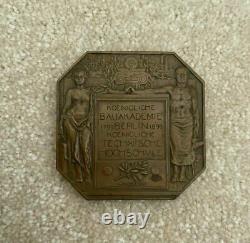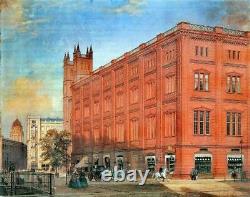1799 1899 Berlin Academy Germany Bauakademie Bronze Medal Kilppe Royal Technical






1799 1899 BERLIN ACADEMY GERMANY BAUAKADEMIE BRONZE MEDAL KILPPE ROYAL TECHNICAL. We welcome any comments, questions, or concerns. WE ARE TARGETING A GLOBAL MARKET PLACE.
Thanks in advance for your patronage. Please Be sure to add WDG to your. NOW FOR YOUR VIEWING PLEASURE. GERMAN COMMEMORATIVE MEDALLION LARGE BRONZE KLIPPE FACE READS: "KÖNIGLICHE BAUAKADEMIE 1799 BERLIN 1899 KÖNIGLICHE TECHNISCHE HOCHSCHULE" LOOSLEY TRANSLATED: "ROYAL BUILDING ACADEMY 1799 BERLIN 1899 ROYAL TECHNICAL UNIVERSITY" CAST MEDAL DEPICTS A MAN AND A WOMAN HANDS HELD OF THE PLAQUARD PROTECTING WISOM AND KNOWLEDGE.
REVERSE READS: "TECHNISCHEN HOCHSCHULE KULTUSMINISTER DER KOENICLICHEN" LOOSLEY TRANSLATED: "TECHNICAL UNIVERSITY MINISTER OF CULTURE OF THE KOENICLICHEN" IMAGE DEPICTS AN ELABORATE / ORNATE FACE OF MEDUSA IN MASK HELMET AVERTING EVIL. OCTAGON SHAPED EXONUMIA IS ABOUT 72mm SQUARE HALLMARK A. The Bauakademie (Building Academy) in Berlin, Germany, was a higher education school for the art of building to train master builders. It originated from the construction department of the Academy of Fine Arts and Mechanical Sciences (from 1704), which emphasized the aesthetic elements of art of building while ignoring the technical. Thus, the governmental Upper Building Department ("UBD") decided to establish an entirely new building educational institution named "Bauakademie". It was founded on 18 March 1799 by King Frederick William III and, in 1801, incorporated into the UBD, as its section. The building of the Building Academy (Bauakademie), built between 1832 and 1836 (later known as Schinkel's Bauakademie), is considered one of the forerunners of modern architecture due to its hithertofore uncommon use of red brick and the relatively streamlined facade of the building. Designed by Karl Friedrich Schinkel, it was built near the Berlin City Palace and accommodated two royal Prussian institutions: the State Construction Commission (Oberbaudeputation), of which Schinkel was the director, and - first of all - the Building Academy (institution), which in 1879 gave birth to the Royal Technical Higher School (Königlich Technische Hochschule Charlottenburg) - the forerunner of the Technical University of Berlin. This institution, under its director Albrecht Meydenbauer, became the first world-wide office professionally working with photogrammetry and establishing an archive of historical buildings based on photography. By 1920, approximately 20.000 glass-negatives of the format 30x30 cm and 40x40 cm had been collected in Germany and abroad. During the Weimar period, the Bauakademie was the home of the famous Deutsche Hochschule für Politik as well as other institutions supported by the State of Prussia.Damaged during World War II, the Bauakademie was then partially restored, but in 1962 the building was demolished to make room for the future Ministry of Foreign Affairs of East Germany. In 1995, the Ministry of Foreign Affairs of East Germany was demolished in order to recreate the Werderscher Markt area. Since then, proposals to rebuild Schinkel's Bauakademie have been discussed with city and Federal authorities. The Werderscher Markt area has already been partially recreated by the Bertelsmann-funded reconstruction of the Alte Kommandantur.
As for the Bauakademie, between 2000 and 2001 students erected a temporary structure to give an impression of the volume and form of the building. On November 11, 2016, the German Bundestag decided to rebuild the building academy according to the motto "As much Schinkel as possible". The cost of the project is estimated at 51 million euros. The Bauakademie sponsorship association, founded in 1994, suggested that it be rebuilt as an international innovation, exhibition and event center with adapted interiors and faithful facades.Between 2004 and 2019, a giant poster recreated the original exterior view of the Bauakademie, similar to the previous oneCity Palace. In October 2016, the President of the Prussian Cultural Heritage Foundation, Hermann Parzinger, combined his public appeal to use all his might for the reconstruction of the Bauakademie with the proposal to use the building as an architecture museum.
In view of the many interested Berlin visitors, it is difficult to understand that this city, with its architectural development over the past 200 years, which has been shaped by numerous urban planning initiatives and upheavals, does not yet have a major architecture museum. Berlin has outstanding, but fallow architectural collections and estates of important architects, such as those in the art library and the state library, in the architecture museum of Technical University of Berlin, in the Academy of the Arts and in the Berlinische Galerie: Isn't it a fascinating idea to finally bring all the treasures of these institutions together in one center?
Changing exhibitions from a historical as well as contemporary perspective could then be devoted to architecture and urban planning in Berlin and the world. On November 11, 2016, the German Bundestag decided to release 62 million euros for the reconstruction of the building academy. It should be a "national showcase, forum and workshop in one" for current topics relating to architecture, construction and urban development as well as another cultural focus on Museum Island, which is "committed to the historical model and dedicated to all construction". Construction is expected to start in 2021. On May 7, 2018, the Federal Ministry of the Interior announced the results of an internationally open program competition for the building academy to be rebuilt.In August 2018, Berlin's Senator for Construction Katrin Lompscher (Die Linke) spoke out in favor of the reconstruction of the Bauakademie under the motto "As much Schinkel as possible". The implementation competition for the building should "take into account Schinkel's specifications for the building, structure and facade".
In January 2019, the Federal Bauakademie Foundation was founded as the supporting organization for the reconstruction of the building. In November 2019, the SPD politician Florian Pronoldas the founding director and in January 2020 the cultural manager Julia Rust von Krosigk was elected as the vice director of the Bundesstiftung Bauakademie.
Pronold's election provoked criticism in parts of the architecture community, which the Federal Ministry of the Interior, the Building Academy and Pronold himself rejected. Two competitors filed a lawsuit against the recruitment process. On January 7, the labor court in Berlin issued an injunction in the proceedings of the plaintiff Philipp Oswalt, which prohibited the foundation from filling the director's position with Pronold, as the proceedings did not meet the requirements of the best selection that apply to public office.
On March 10, 2020, Pronold announced that it would not take up the position as director On June 12, the regional labor court confirmed the temporary injunction as a second instance on the grounds that the Federal Bauakademie Foundation is designed according to the rules of the statutes in the sense of continued state control. The Federal Republic of Germany as the founder, represented by the Federal Government, represented by the Federal Ministries, has a continuing significant influence in the sense of a possible implementation of essential decisions. There is a financial and personal dependency,'ruling through' in the above sense is possible. On September 9, 2020, the Federal Ministry of the Interior for Building and Home Affairs announced that the director's position would be based on the judgment of the Berlin-Brandenburg State Labor Courtis rewritten. Berlin is the capital and largest city of Germany by both area and population.
Its 3.8 million inhabitants make it the European Union's most populous city, according to population within city limits. One of Germany's sixteen constituent states, Berlin is surrounded by the State of Brandenburg and contiguous with Potsdam, Brandenburg's capital.
Berlin's urban area, which has a population of around 4.5 million, is the second most populous urban area in Germany after the Ruhr. The Berlin-Brandenburg capital region has over six million inhabitants and is Germany's third-largest metropolitan region after the Rhine-Ruhr and Rhine-Main regions. Berlin straddles the banks of the Spree, which flows into the Havel (a tributary of the Elbe) in the western borough of Spandau. Among the city's main topographical features are the many lakes in the western and southeastern boroughs formed by the Spree, Havel and Dahme, the largest of which is Lake Müggelsee. Due to its location in the European Plain, Berlin is influenced by a temperate seasonal climate. About one-third of the city's area is composed of forests, parks, gardens, rivers, canals and lakes. The city lies in the Central German dialect area, the Berlin dialect being a variant of the Lusatian-New Marchian dialects. Berlin in the 1920s was the third-largest municipality in the world. East Berlin was declared capital of East Germany, while Bonn became the West German capital. Following German reunification in 1990, Berlin once again became the capital of all of Germany. Berlin is a world city of culture, politics, media and science. Its economy is based on high-tech firms and the service sector, encompassing a diverse range of creative industries, research facilities, media corporations and convention venues. Berlin serves as a continental hub for air and rail traffic and has a highly complex public transportation network. The metropolis is a popular tourist destination. Significant industries also include IT, pharmaceuticals, biomedical engineering, clean tech, biotechnology, construction and electronics. Berlin is home to world-renowned universities such as the Humboldt Universität zu Berlin (HU Berlin), the Technische Universität Berlin (TU Berlin), the Freie Universität Berlin (Free University of Berlin), the Universität der Künste (University of the Arts, UdK) ESMT Berlin and Bard College Berlin.Its Zoological Garden is the most visited zoo in Europe and one of the most popular worldwide. With the world's oldest large-scale movie studio complex, Berlin is an increasingly popular location for international film productions.
The city is well known for its festivals, diverse architecture, nightlife, contemporary arts and a very high quality of living. Since the 2000s Berlin has seen the emergence of a cosmopolitan entrepreneurial scene. Berlin contains three World Heritage Sites: Museum Island; the Palaces and Parks of Potsdam and Berlin; and the Berlin Modernism Housing Estates. Other landmarks include the Brandenburg Gate, the Reichstag building, Potsdamer Platz, the Memorial to the Murdered Jews of Europe, the Berlin Wall Memorial, the East Side Gallery, the Berlin Victory Column, Berlin Cathedral and the Berlin Television Tower, the tallest structure in Germany.
Berlin has numerous museums, galleries, libraries, orchestras, and sporting events. These include the Old National Gallery, the Bode Museum, the Pergamon Museum, the German Historical Museum, the Jewish Museum Berlin, the Natural History Museum, the Humboldt Forum, the Berlin State Library, the Berlin State Opera, the Berlin Philharmonic and the Berlin Marathon. Berlin lies in northeastern Germany, east of the River Elbe, that once constituted, together with the River (Saxon or Thuringian) Saale (from their confluence at Barby onwards), the eastern border of the Frankish Realm. While the Frankish Realm was primarily inhabited by Germanic tribes like the Franks and the Saxons, the regions east of the border rivers were inhabited by Slavic tribes.
This is why most of the cities and villages in northeastern Germany bear Slavic-derived names (Germania Slavica). Typical Germanized place name suffixes of Slavic origin are -ow, -itz, -vitz, -witz, -itzsch and -in, prefixes are Windisch and Wendisch. The name Berlin has its roots in the language of West Slavic inhabitants of the area of today's Berlin, and may be related to the Old Polabian stem berl-/birl- ("swamp"). Since the Ber- at the beginning sounds like the German word Bär (bear), a bear appears in the coat of arms of the city. It is therefore an example of canting arms. Of Berlin's twelve boroughs, five bear a (partly) Slavic-derived name: Pankow (the most populous), Steglitz-Zehlendorf, Marzahn-Hellersdorf, Treptow-Köpenick and Spandau (named Spandow until 1878). Of its ninety-six neighborhoods, twenty-two bear a (partly) Slavic-derived name: Altglienicke, Alt-Treptow, Britz, Buch, Buckow, Gatow, Karow, Kladow, Köpenick, Lankwitz, Lübars, Malchow, Marzahn, Pankow, Prenzlauer Berg, Rudow, Schmöckwitz, Spandau, Stadtrandsiedlung Malchow, Steglitz, Tegel and Zehlendorf. The neighborhood of Moabit bears a French-derived name, and Französisch Buchholz is named after the Huguenots. The history of Berlin starts with its foundation in the 13th century. It became the capital of the Margraviate of Brandenburg in 1417, and later of Brandenburg-Prussia, and the Kingdom of Prussia. Prussia grew rapidly in the 18th and 19th centuries, and formed the basis of the German Empire in 1871, which survived until 1918, after the empire's defeat in World War I. After 1900 Berlin became a major world city, known for its leadership roles in science, the humanities, music, museums, higher education, government, diplomacy and military affairs. It also had a role in manufacturing and finance. During World War II, bombing, artillery, and ferocious street-by-street fighting destroyed large parts of Berlin. Troops would also hide in buildings. Berlin was divided among the four major Allied powers. For over four decades, it encapsulated the Cold War confrontation between West and East. With the reunification of Germany in 1990, Berlin was restored as a capital and as a major world city. (THIS PICTURE FOR DISPLAY ONLY). Please leave feedback when you have received the item and are satisfied. Please respond when you have received the item. Our goal is for 5-star service. We want you to be a satisfied, return customer. Please express any concerns or questions. More pictures are available upon request. Please Check out our other items. WE like the curious and odd. Get Supersized Images & Free Image Hosting. Create your brand with Auctiva's. Attention Sellers - Get Templates Image Hosting, Scheduling at Auctiva. This item is in the category "Coins & Paper Money\Exonumia\Medals".The seller is "cbenhob" and is located in this country: US. This item can be shipped worldwide.
- Modified Item: No
- Country/Region of Manufacture: Germany
- Circulated/Uncirculated: Circulated
- Composition: Bronze
- Brand: A.

